My favorite miso soup recipe, just like the way my mother makes it! This recipe is light, comforting, and full of savory umami flavor — and only requires 4 ingredients and 15 minutes of your time to make!

Miso soup is a nutty and savory soup made of dashi broth and miso paste, often served as part of a traditional Japanese meal. Next to sushi, it’s what most people refer to whenever they say they crave Japanese food. While most miso soups are made with wakame seaweed and silken tofu, my mother only uses chopped onions as the filler ingredient. The soup takes on a sweet fragrance, making the broth very delicate, yet still deep in flavor. The onions are boiled until tender and literally melt in your mouth, it’s absolutely delicious!
This easy miso soup recipe only needs 4 ingredients and comes together in minutes. Whether you are looking for a traditional Japanese side dish or a cozy bowl of soup to enjoy on its own, this miso soup will not disappoint. For those new to Japanese cooking or who don’t have access to specialty ingredients, keep reading as I will walk you through simple substitutions and tips to make delicious miso soups.
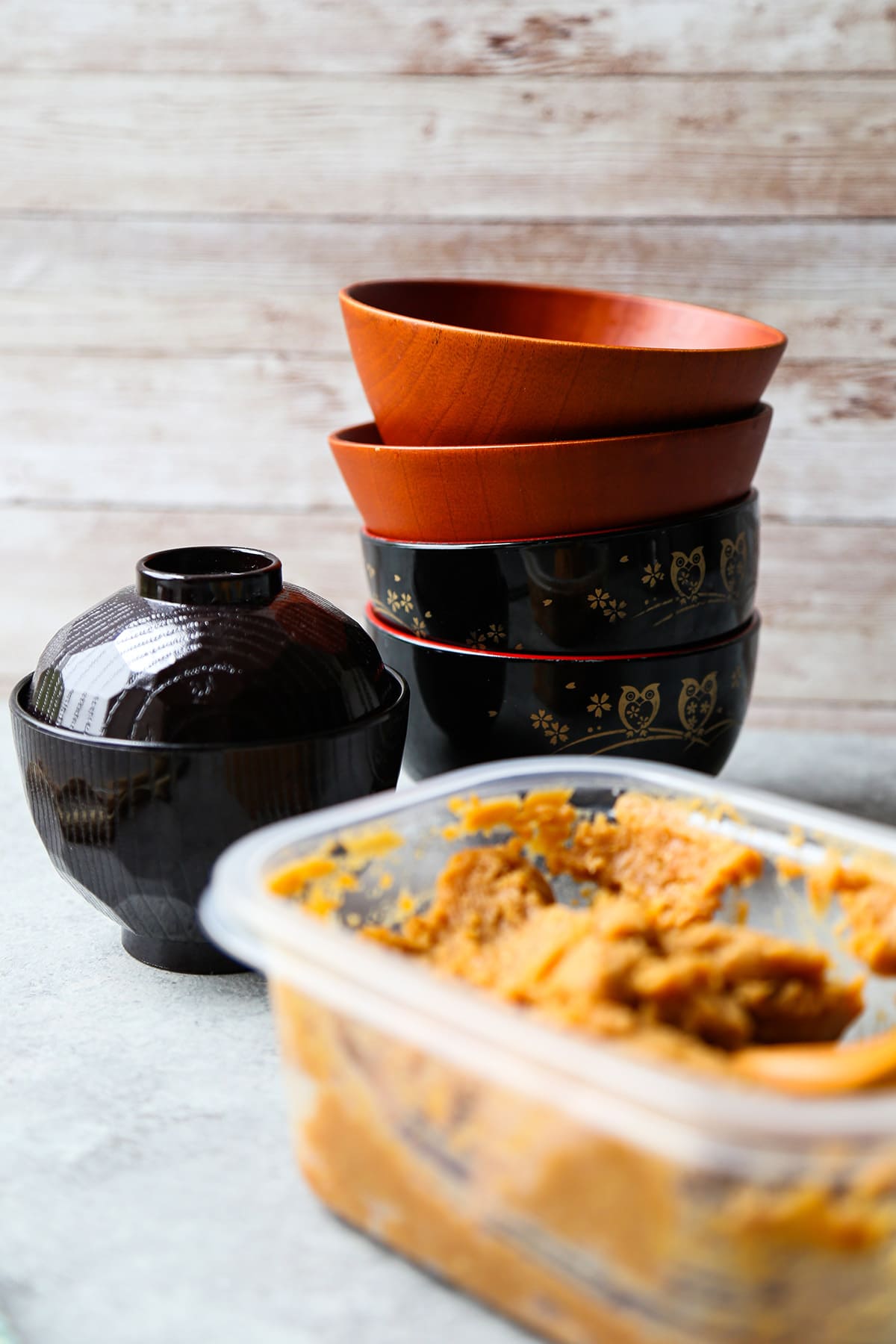
First Time Making Miso Soup? Here Are The Basics
If you are new to miso soup, here are a few things to know:
- It’s very easy to prepare. Miso soup can be made with just dashi broth, miso paste, and green onions. The only cooking technique required is boiling. It couldn’t get any easier than that!
- Miso paste should never boil and should always be added last. This is to prevent the paste from losing flavor and nutrients.
- Various ingredients can be used. Most of us are familiar with the classic combination of tofu and wakame seaweed, but did you know that across Japan, there are endless recipe variations of miso soup? From my mother’s recipe with onions, there is also miso soup with potatoes, miso soup with maitake mushrooms, with eggplant, daikon – even natto! The options are endless.
Best Miso Paste For This Recipe
You can technically use all three types of miso paste – red, awase, and white – to make this miso soup, but I recommend using white miso paste because of its light and delicate taste. Awase miso paste is the second best option but is saltier and more aggressive overall.
If you are interested in cooking more with miso paste, try my miso dressing, nasu dengaku (broiled eggplant with miso glaze), spicy miso ramen, miso salmon, or miso roasted daikon.
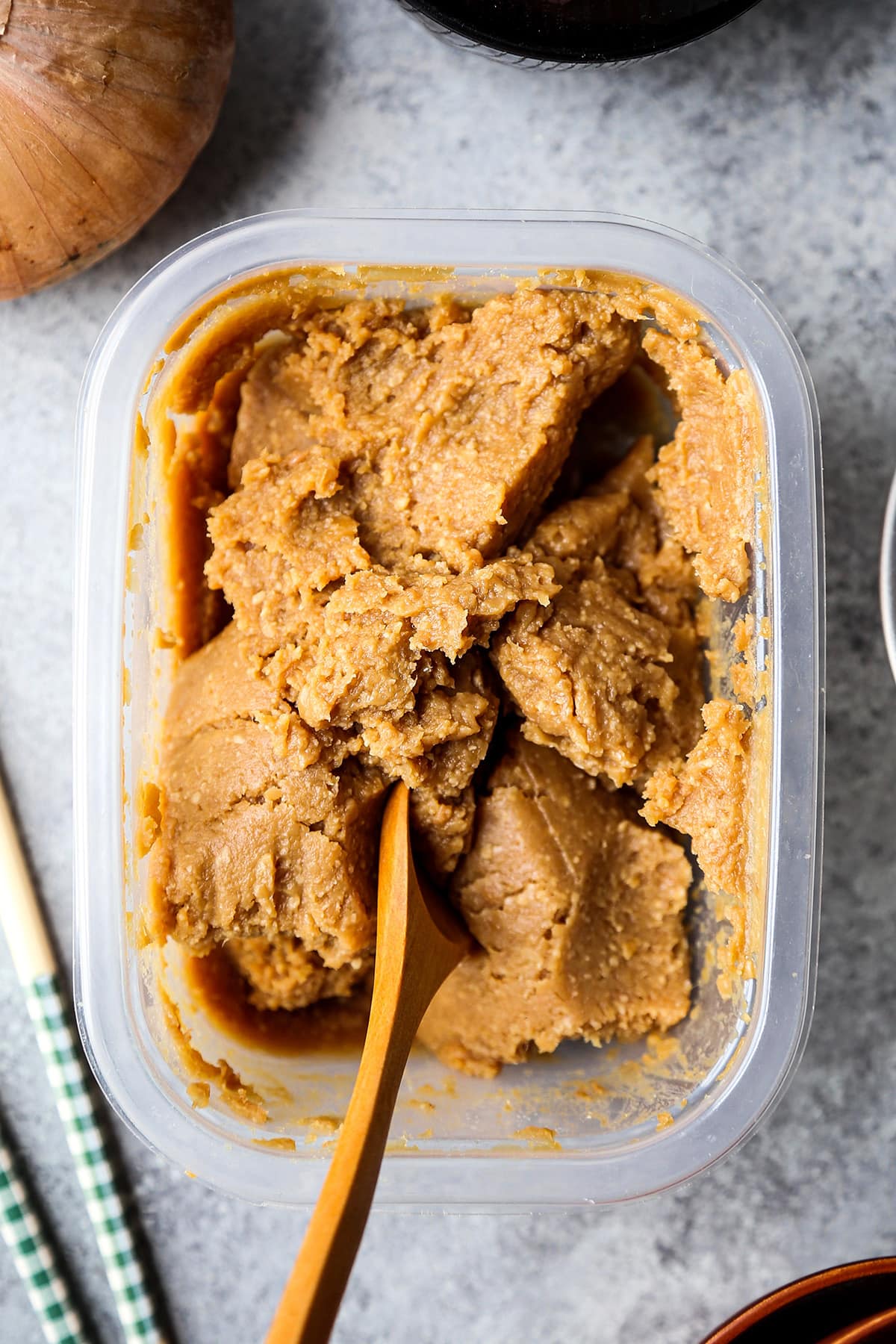
Miso Soup Ingredients
- Onion: Don’t be afraid to use plenty of onions as they add sweetness and depth of flavor. Plus, once boiled onions become so tender they almost melt in your mouth, which is a big bonus!
- Dashi powder: Dashi powder is made from a mixture of ground seaweed and bonito flakes and is at the core of Japanese cooking. It gives soups and dishes a light briny and smoky taste without being overwhelming.
- Water: 4 cups of water to mix with the dashi powder.
- Miso paste: My mother and I like to use white (shiro) miso paste for this soup because of its most delicate flavor, which also happens to be beginner friendly. If you don’t have white miso paste, awase miso paste, which is a mix of white and red miso paste, also works.
- Ichimi togarashi (optional): Ichimi togarashi are ground red chili peppers used to impart a little heat to the soup. This ingredient is optional.
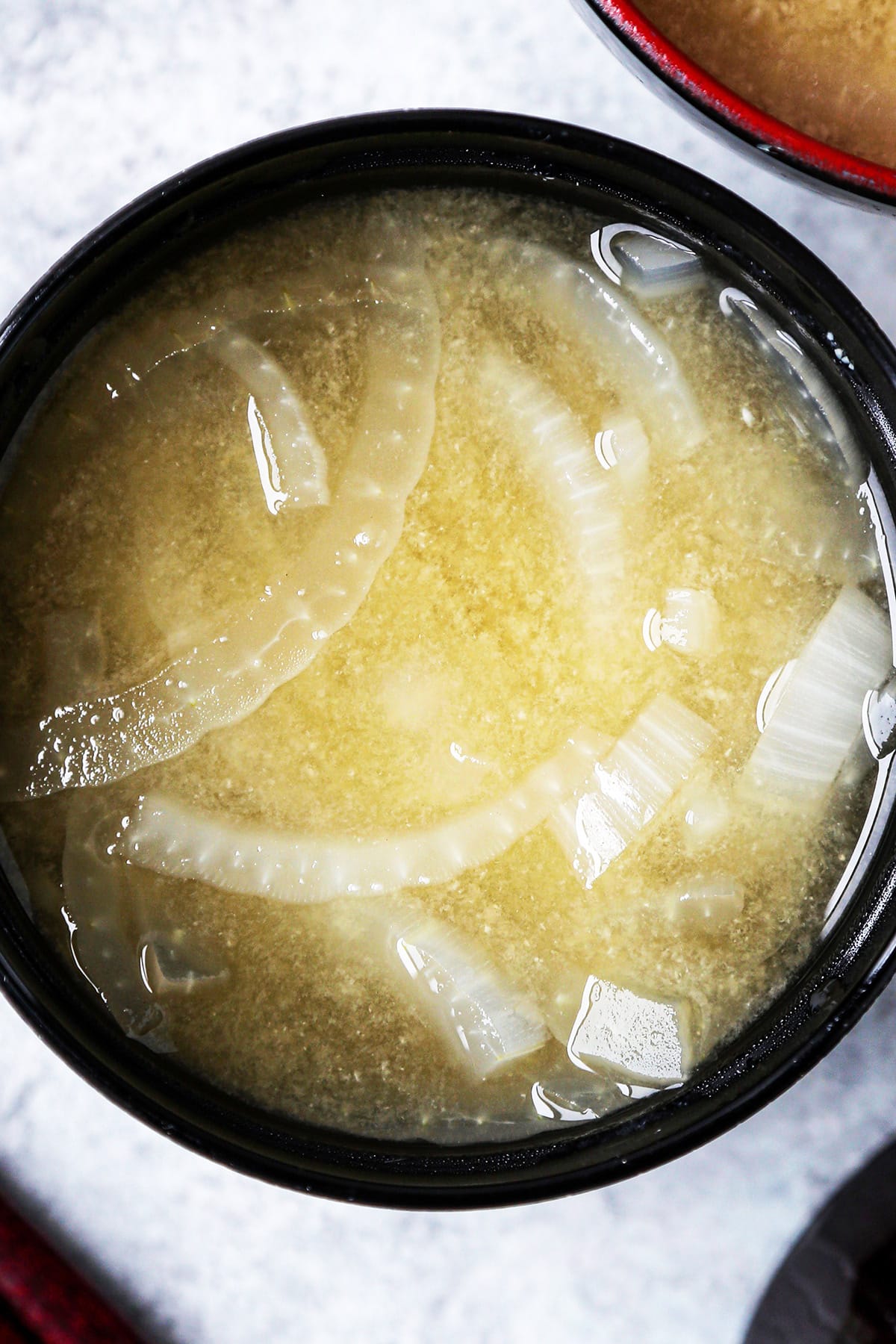
How To Make Miso Soup
Scroll down to the recipe card for the full recipe.
- Bring the soup to a boil. Add 4 cups of water, onions and dashi powder to a pot and bring to a boil.
- Let it simmer. Lower the heat, cover and cook for about 10 minutes, until the onions are tender.
- Add the miso paste. Place the miso paste in a colander and lower it into the pot until enough water covers the miso paste.Using chopsticks, swirl the paste until it completely dissolves into the soup.
- Serve. Turn the heat off and serve in small bowls with ichimi on the side.
Substitutions
- Traditional. For the traditional soup with tofu and seaweed, bring the water and dashi to a boil, add the tofu and cook for 2 minutes. Follow the same steps for dissolving the miso paste, and finish by adding the seaweed (wakame).
- Vegan. Use kombu dashi instead or regular dashi which is made with bonito flakes (katsuobushi). Also, make sure that the miso paste you are buying doesn’t contain any dashi and is 100% miso paste only.
- More Flavorful. Adding a drizzle of toasted sesame oil will infuse the broth with a lovely nutty taste. I also sometimes like to add ground sesame seeds for the same effect.
- More Filling. Add a couple of pieces of mochi to the soup when it’s boiling and cook them until they have softened. I love eating miso soup this way as I am obsessed with the chewy texture of rice cakes.
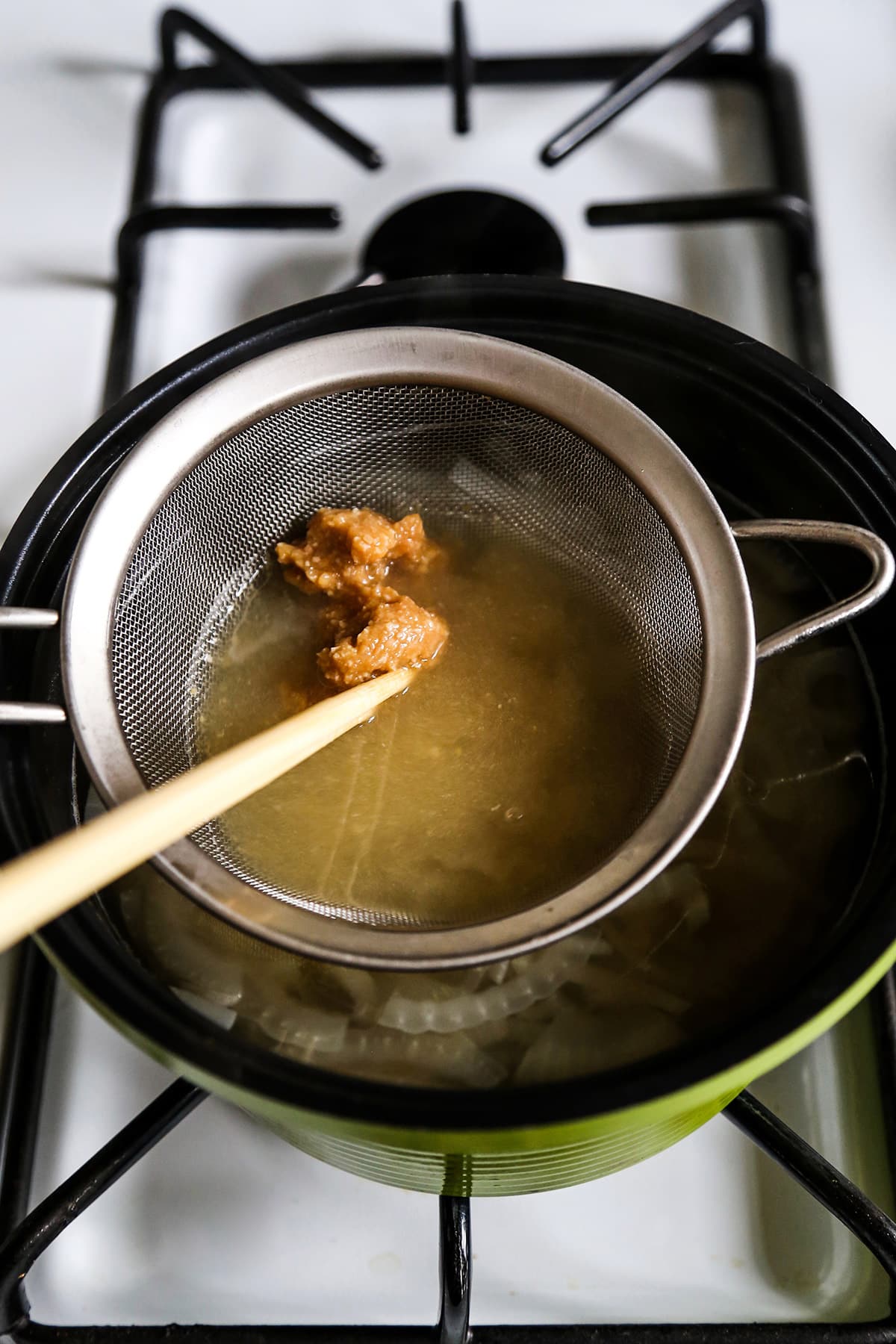
Recipe Tips
Drink it hot but not too hot. Miso soup is best enjoy when it’s hot but not boiling hot. That’s because the flavors of the soup are delicate and more pronounced when the temperature isn’t too elevated.
Use the sweetest onions to enhance sweetness (amami). My mother’s miso soup tastes best when it’s made with a sweeter type of onion so it infuses the broth with sweetness. Onions such as Vidalia or Walla Walla are good options, as well as yellow onions. Avoid using white onions as they have a strong astringent taste.

Serving Suggestions
My favorite way to serve miso soup is in the morning as part of a Japanese breakfast, with rice and a piece of salted salmon (shiozake). I also enjoy having it as mid afternoon pick me up, or with a simple salad or sandwich.
In Japan, miso soup is typically served as a side dish rather than a main course, so feel free to enjoy this delicious dish however you like!
Some dishes to pair with miso soup: Japanese curry rice, omurice, spicy tuna roll, chicken katsu, tamago kake gohan, yaki udon.
Frequently Asked Question
Yes you can. The easiest way to achieve the exact same taste without actually buying dashi powder is to purchase miso paste that already contains dashi. If you simply prefer not to use dashi at all, you can use powdered vegetable stock or seaweed. The soup will taste a little different but still be delicious.
For up to 3 days, stored in an airtight storage container.
Yes you can but it has to be on low heat. To reheat miso soup, put the miso soup in a pot and simmer on low heat. Do not boil miso soup as it’s bad for the miso paste and will affect its taste and delicate aroma.
It depends of the miso paste used. It’s important to read the label if you suffer from gluten allergies since some miso pastes can contain fermented grains like wheat and barley. Look for one that is 100% gluten-free.
Yes you can freeze it too! Let the miso soup cool to room temperature first. Next, divide the soup into individual serving size so it’s easier to thaw and reheat. Use airtight storage containers or freezer bags. Freeze for up to 3 months.
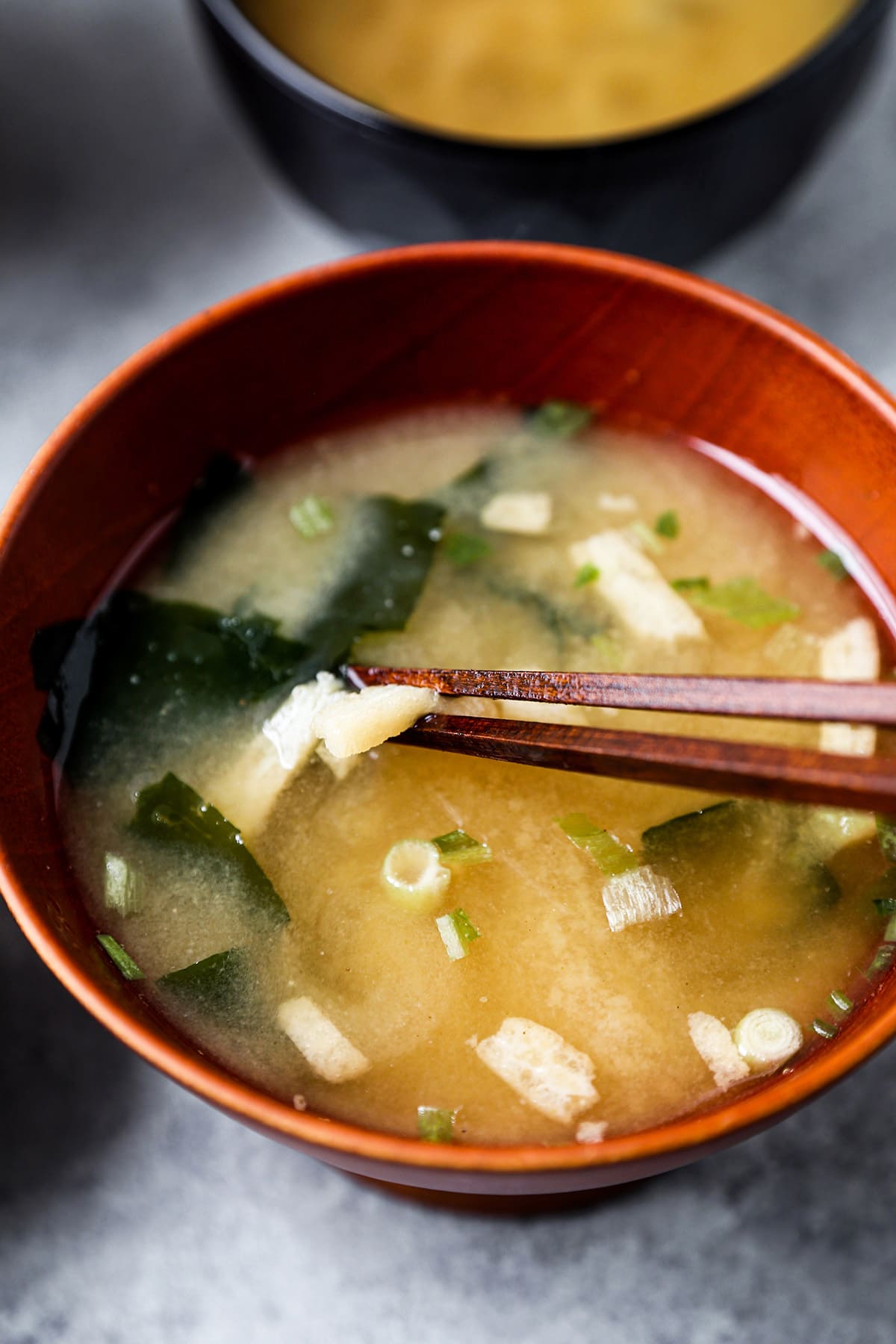
Did you like this recipe? Are there changes you made that you would like to share? Share your tips and recommendations in the comments section below!
Print
Miso Soup
- Prep Time: 5 minutes
- Cook Time: 10 minutes
- Total Time: 15 minutes
- Yield: 4 1x
- Category: Soup
- Method: Stove top
- Cuisine: Japanese
- Diet: Low Calorie
Description
This delicate and savory miso soup only needs 4 ingredients and comes together in minutes.
Ingredients
- 1 large onion, thinly sliced
- 4 cups water
- 1 tablespoon powdered dashi
- 3–4 tablespoons preferably white miso paste or awase miso paste
- Ichimi togarashi (optional)
Instructions
- Make the broth. Put the sliced onions, water and powdered dashi in a pot and bring to a boil. Lower the heat, cover and cook for 10-12 minutes, until the onions are tender.
- Add the miso paste. Place the miso paste in a small strainer and lower the strainer into the pot, until the liquid covers the miso paste. Stir the miso paste with chopsticks until it has fully dissolved.
- Serve. Turn the heat off and serve.
- Add a little heat (optional). Sprinkle a little ichimi togarashi for heat.
Notes
This miso soup will keep for 3 days, refrigerated in an airtight container.
Nutrition
- Serving Size: 4
- Calories: 42
- Sugar: 1.7g
- Sodium: 23.4mg
- Fat: 0.8g
- Saturated Fat: 0
- Unsaturated Fat: 0
- Trans Fat: 0
- Carbohydrates: 7.1g
- Fiber: 1.4g
- Protein: 2.1g
- Cholesterol: 0.3mg



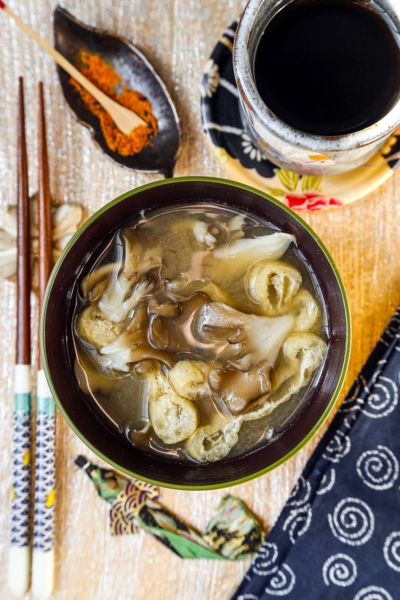















Questions and Reviews
The brands that are linked in the ingredients list, are these the exact items you use? I love miso soup but am so picky about it. I’ve tried multiple brands at our local Asian market but haven’t loved any of them. I would love to be able to eat this multiple times a week.
Hi Megan! Yes, these are all ingredients that I use. As for the miso paste, I change it up between the one that’s linked to the recipe and Miko’s Awase Miso paste. I also like the Shirakiku brand and Hikari miso 🙂
Thank you for the recipe! It was very good 🙂 the ingredients were definitely hard to find in the supermarket so most of the items were bought online. Would you mind sharing which brand of awase miso paste you use? Thank you in advance!!
Hi Claudia! The brands I like to use are Hikari or Miko 🙂
One of my favorite Japanese foods is Miso Soup ! I’ve ordered it at great restaurants all over the world. I’ve tried many of the “ Instant “ soup mixes sold in the stores. I’ve even made it from scratch in my kitchen. I was never thrilled with my cooking attempts! Then I was lucky enough to come across this recipe on line !! WOW !! This is the Absolute Best soup ever !!! So Savory! So Unami Tasty ! So Delicious!! I was a little leery about the white sweet onions and the amount. Only used green shallots before this. But Caroline Phelps is right , they melt in your mouth, and don’t overpower the soup in anyway! And yes the Awase Miso is PERFECT! Not too sweet , not too smoky. THANK YOU , Caroline and to your Mother, for this FANTASTIC WONDERFUL recipe !! I will cherish it always!!
Michael,
That is such a nice comment, you have no idea how happy you just made me! Thank you so much, and I will pass the word along to my mother as well 🙂
Great miso recipe. I love the strainer trick,I’ve never thought of that. I haven’t heard of putting fresh clams in miso, what are your steps for that modification?
Hi Courtney! Clean and rinse the baby clams well before using and add them to the miso soup just a couple of minutes before serving. It’s one of my favorites, so delicious!!
Just made the miso soup. OMG! My husband loves it. I used Hondashi bonito soup stock. Can’t wait to try the Riken brand. Wait til I make the soup at family reunion. It is cold and going for second serving.
That’s great Belta, so happy you enjoyed it! 🙂
I cooked miso soup for the first time today and it was delish! The pot was wiped clean! Fantastic recipe!!
I have tried several miso soup recipes. This is the best recipe on miso soup I found on internet. The information provided is clear and thorough.
I tried making dashi from scratch. I ran into a problem looking for bonita flakes in the supermarket, especially when package is not in english. It is just awesome that you provide alternatives.
I can’t wait to use your recipe this weekend. It is a perfect time to make soup in cold weather.
I am also looking forward to making sushi. I can’t wait to get recipe book.
Thank you so much Belta, I will share your comment with my mother, she will be so happy! 🙂
What type of miso do you prefer? And are there any brands you recommend?
Hi Leala! I like white or awase miso paste for miso soup. If you prefer it salty and smoky, then go for red miso paste. As far as brands, I like Hikari, Marukome, Hanamaruki, and Miko. 🙂
Thank you so much! I got the Hikari organic white miso. I just made your recipe, and it is absolutely delicious! It is on par with the miso soup I get at restaurants. Thank you so much!
Thank you so much Leala! 🙂
Thank you for this recipe, it’s my go to, it’s simple and delicious. I also appreciate the links for ingredients. I love all the recipes I have found on your website.
I love the salad dressing to hat has ginger and carrots in it, I LoVE it.
Thank you for sharing your family recipes.
Thank you so much Paula, you just made smile from ear to ear 🙂
My husband and I went to Japan several years ago and I fell in love with the food.
The Riken brand of powdered dashi that you mention was recommended to me by a woman who owns a small Japanese grocery close to my office here in the United States. She told me “All the Japanese housewives use this” lol. It’s so good and so simple to use, and your recipe is delicious!
Thank you so much Erika! 🙂
This hit the spot. The best miso soup I’ve ever had and the first I’ve attempted to make. I used Dashi granules and added some tofu with a little nori on top to serve. Thanks for sharing your mom’s amazing recipe!
Thank you so much Barbara, this makes me so happy! 🙂
Thank you so much for sharing this recipe. The first recipe I’ve used that gives a delicate and full- flavored miso broth! I do make my own kombu dashi for this for a vegan version. I’ve made with Vidalia onions and occasionally include either mushrooms or Wakame. This is my go-to recipe from now on!
I have made several attempts at other miso recipes. This is by far the best and the easiest. No need to keep searching for any other recipe.
Thank you so much Andrea! 🙂
Approx. how much tofu and wakame are you roughly adding. I know a little goes a long way with the seaweed. Thank you!
Hi Craig! You’re absolutely right by saying that a little goes a long way with wakame 🙂 I usually add 5 or 6 pieces per bowl and right before serving so they are fresh and not slimy. As for tofu, use silken and dice them quite small (smaller than bite size is better). 2 tablespoons per bowl is about right.
Very good simple recipe!!! Found everything I needed at the local Asian market (the miso paste will be in the refrigerated section). Will be adding this to the normal lunch rotation. Thanks!!!
You are so welcome Nichi! And I’m sure my mother will also be happy to know that so many people love her miso soup as much as I do! 🙂
Hello from Texas!
I ADORE miso soup… my whole family does really. I cannot wait to try your recipe!! I have never made miso before… and to be quite honest… I’ve never bought tofu either. What would be the best tofu to use? Also what kind of seaweed. Is it dried or fresh? I would appreciate all the help I can get! Thanks so much in advance!
-Leta
Hi Leta! Silken tofu is the only type I recommend for using in soups because of it’s delicate silky texture. As for seaweed, look for the dry wakame type, which you can find in every Asian grocery store, or here on Amazon. https://www.amazon.com/Wakame-Dried-Seaweed-Ounce-Shirakiku/dp/B0086XRRMW/ref=sr_1_5?crid=1ESL1VIG36BWA&keywords=wakame+seaweed&qid=1581950802&sprefix=wakame%2Caps%2C165&sr=8-5
Absolutely divine! My previous attempts at making miso soup did not even come close to this recipe. Clearly simple is best with miso soup. I changed my liquid concentrated dashi to the HonDashi granules mentioned in the article. Wow! What a difference! Thank you Caroline for another recipe that my Japanese mom would love:)
You are so welcome Carol, your message put a big smile on my face 🙂 ❤️
I LOVE the tip of using the strainer to help dissolve the clumps of miso. Brilliant! Thank you!
It is so easy and so delicious, I used a Dashi Miso paste so I didn’t add the flakes and it is amazing. My three boys all loved it too. What a crowd pleaser, it was so fast to make. I have gone to the store for Miso paste alone several times since the first and it is always great.
Wonderful Wendy! I make miso soup almost every day for the exact same reasons – because it’s so easy and so delicious! 🙂
I LOVE your blog and traditional recipes that include short cuts without the guilt from not preparing all ingredients from scratch. This miso recipe is simple yet tastes wonderfully complex from the cooked onions, hon dashi and miso combination. I am Sansei and was unable to capture my mom’s Japanese recipes because she rarely wrote them down. Finding your blog filled so many gaps in how I cook (or tried to cook) Japanese food. Many thanks for creating an amazing blog with background stories that make recipes come alive. Now off I go to the Japanese grocery store to find Riken dashi so I can decide if I have a new favorite to add to my pantry. 🙂
Thank you Carol for the beautiful comment! I always ask my mother about her recipes and though she never writes them down (just like your mother – is it a Japanese thing? ;P) she can always recreate her dishes the same way. Nowadays, whenever I’m in Japan visiting her, I make sure to keep notes on how she makes my favorite dishes, including using measuring cups and spoons (she always looks at me like I’m crazy haha!). I’m so happy you are able to capture some of your mother’s flavors, there’s nothing more comforting than a mother’s love 🙂
No it’s NOT a Japanese thing-it’s a Mother thing!. My mom’s from Missouri in USA, her mom is from Kentucky. Neither one of them have ever written down a recipe in their lives, never accurately measured anything and never really willingly shared a recipe outside the family!!
That’s too funny Kaye! And that’s why so many of us start food blogs so we can try to recapture some of mom’s amazing food. Maybe we all need to have a serious talk with them and tell them to write that stuff down!
I’ve been making miso soup everyday for over a year, and decided to follow your recipe today. It was the best.miso.soup.ever!!! Thank you. I especially liked the miso in the strainer.
That’s wonderful Karen! I’m really happy you like my mother’s recipe, I’ll let her know 🙂